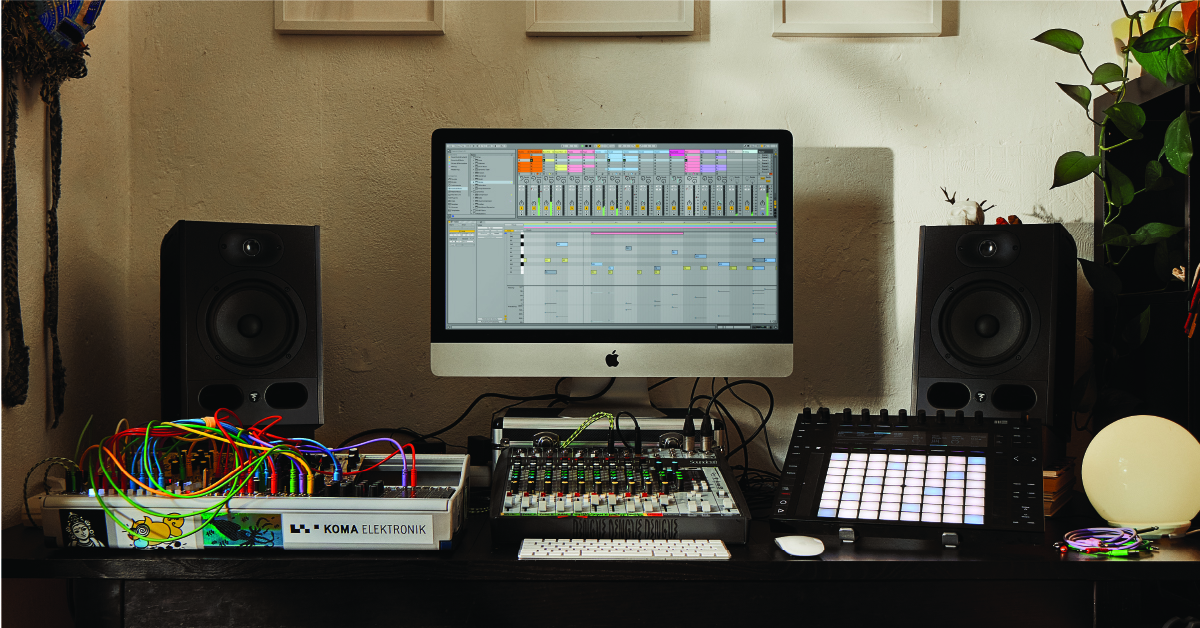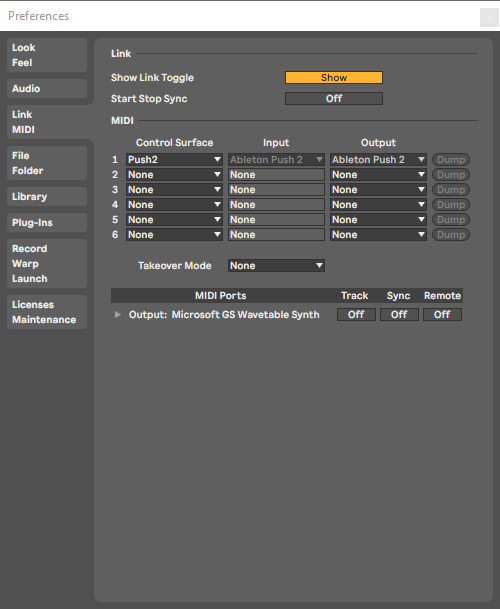Ableton Enable Two Tracks to Re Cord

In this guide, we will show you how to get up and running with Ableton Live. We'll cover setting up your audio and MIDI device, as well as scanning and adding plug-ins. After you've successfully activated and installed the DAW, follow the steps below to get started.
- Select your audio device
- Configure the inputs and outputs
- Create and record audio tracks
- Enable MIDI devices
- Create and record MIDI tracks
- Scan add plug-ins in Ableton Live
- How to add a plug-in onto a track
Before you can record in Live, you first need to select your audio device and activate the inputs and outputs. You can also change things like your sample rate, make changes to your routing, and make changes to project performance for a better overall experience. Follow the steps below to select your audio device.
- To get to your hardware device settings, go to the Options menu on the top toolbar, click Preferences, then click the Audio tab on the left-hand side of the window.
- Choose ASIO from the Driver Type menu, then select your preferred audio device from the Audio Device menu.
- Click Hardware Setup to open your audio driver's interface page to change the project's sample rate and the audio hardware buffer size.
- Changing the buffer size affects the latency while recording. Depending on your computer, a lower buffer size will reduce latency but can cause distortion and dropouts, especially when you add more tracks and plug-ins.
RETURN TO TOP ↑
If your audio interface does not show up in Live, make sure you've downloaded and installed the correct drivers, and also visit our troubleshooting guides for PC and Mac.
Configure the inputs and outputs
If your input or output options are not showing up, you might not have the correct audio device selected within Live. Visit the Select the audio device section and check that your inputs are active in the I/O settings in the Input Config settings.
Now that your audio device is selected, we need to configure the input and output settings in Live. This means you're connecting the hardware channels from your audio device to the software paths in Live. Follow the steps below to update Live's I/O settings.
- In the Audio window, click Input Config and activate all inputs you will be using. Follow the same procedure for the output configuration.
- To confirm you are getting sound, click the Test Tone button and make sure everything is working correctly.
How to Route Your Audio Interface in Ableton Live
RETURN TO TOP ↑
Create and record audio tracks
Once your audio hardware is connected and your input and output channels are set up with Live, the next steps are to create and record an audio track. The two most common types of audio tracks used are Mono (one channel) and Stereo (two channels). Once you've created the audio tracks, you'll need to update the track's input to the correct channel from your audio device. Follow these steps to create and configure your audio tracks.
- Click the Create menu from the top taskbar, then click Audio Track.
- Make the I/O section viewable by clicking the View menu, then clicking In/Out.
- Click the drop-down box on the audio channel to select the input you're recording from.
- Record-enable the track(s) by clicking the Record button on the track.
- Press the Record button on the transport bar to start recording.
- Press Stop or your space bar to stop the recording.
How to Create a Track in Ableton Live
RETURN TO TOP ↑
If you're using a MIDI device, Live needs to recognize that it's connected to your computer first. While some devices may require additional drivers, others will not, so be sure to refer to the manual for your MIDI device and follow those instructions before continuing. Once the MIDI device is set up, it will be selectable within Live, and you can start recording MIDI data. Follow the sections below to select and play with MIDI and virtual instruments.
- Go to the Options tab, click Preferences, then click the Link/MIDI tab on the left.
- Locate your MIDI device in the Input section and turn the Track button to ON to enable it. Follow the same procedure for your MIDI device output listed.
- If you plan on using an external MIDI controller or sequencer, turn the Sync on, and if you plan on using any MIDI controller pads or knobs, turn the Remote on. In both cases, however, you will need to make sure that Remote is turned off in the Output section.
- To test your MIDI is set up correctly, press a key/pad and look at the track to see if you're getting input.
USB and MIDI connections in Ableton Live
MIDI devices can connect to your DAW via USB or MIDI. USB is often used because it also powers the device, but it can take up USB ports. A solution to this is to use a USB port, and we recommend using one that includes its power supply. Without it, the computer's USB port connecting it may not power all the hub's devices.
Another way to input MIDI data to your DAW is via MIDI cables. MIDI cables don't provide power but can be daisy-chained between MIDI devices. So long as your MIDI device is powered, connect its MIDI In and Out jacks to a MIDI device connected to your computer. This could be with a USB MIDI Interface, audio interface, or even another MIDI device.

Adjust your MIDI hardware settings in the MIDI Settings window.
RETURN TO TOP ↑
Create and record MIDI tracks
Once your audio hardware is connected and your input and output channels are set up with Live, the following steps are to create and record an audio track. The two most common audio tracks used are Mono (one channel) and Stereo (two channels). Once you've created the audio tracks, you'll need to update the track's input to the correct channel from your audio device. Follow these steps to create and configure your audio tracks.
- Click theCreatemenu from the top taskbar, then clickAudio Track.
- Make the I/O section viewable by clicking theViewmenu, then clickingIn/Out.
- Click the drop-down box on the audio channel to select the input you're recording from.
- Record-enable the track(s) by clicking theRecordbutton on the track.
- Press theRecordbutton on the transport bar to start recording.
- PressStopor your space bar to stop the recording.
To get sound out of MIDI data, you must send it to a virtual instrument (VI). You can insert VI's into an audio or aux track. Once done, update your MIDI track's output to one of the VI's MIDI input channels. Now the MIDI will record on one track and sound out of the other.
Creating a MIDI track.
RETURN TO TOP ↑
Scan and add plug-ins in Ableton Live
ONE FOLDER ONLY! Ableton Live only scans plug-ins from one folder, so ensure all of your plug-ins are installed in the same place!
During the plug-in installation process, you will be asked where to install the plug-in. Live can only scan one plug-in folder, so be sure to have all of your plug-ins installed to the same location so you can add that to Live. If your plug-ins aren't showing up after installation, you may need to close and restart Live. If that doesn't do the trick, Live may need to rescan the plug-ins. Follow these steps to add and rescan your plug-ins.
- Go to the Options menu, click Preferences, then the File/Folder tab on the left. In the Plug-In Sources section, click re-scan. Close and restart Live.
- Go back to the File/Folder tab of the Preferences window to see if the Use VST Plug-In Custom Folder button is turned on in the window. Take note of what the folder path is and see if your plug-in is in there.
- If the plug-in still isn't showing up, re-install the plug-in to the folder path Ableton is scanning.
To use plug-ins in Live, you need to insert it on a track. Remember that some plug-ins are mono or stereo only, so keep that in mind when using your effects. You can add audio effects to MIDI tracks but cannot add MIDI effects to audio tracks.
To add a plug-in, just drag the plug-in from the plug-ins menu on the left side of the arrangement window onto the track.
- Watch the CPU Meter to view the plug-in activity. If the activity is very high, increase your buffer size in the Audio settings.
- Increase your project's performance by sending tracks using the same plug-in (like drums) to an FX bus rather than running multiple instances.
- Save plug-in presets with the session or in a custom folder on your computer.
RETURN TO TOP ↑
Related content
Getting Started with Ableton Live
How to Warp and Quantize in Ableton Live
How to Create a Groove in Ableton Live
How to Edit Audio in Ableton Live
Jamming Along with Ableton Live
How to Automate Tempo and Time Signature Changes in Ableton Live's Arrangement View
How to Automate Tempo and Time Signature Changes in Ableton Live Session View
When you need help, Sweetwater has the answers!
Our knowledge base contains over 28,000 expertly written tech articles that will give you answers and help you get the most out of your gear. Our pro musicians and gear experts update content daily to keep you informed and on your way. Best of all, it's totally FREE, and it's just another reason that you get more at Sweetwater.com.
Ableton Enable Two Tracks to Re Cord
Source: https://www.sweetwater.com/sweetcare/articles/ableton-live-quickstart-guide/

0 Response to "Ableton Enable Two Tracks to Re Cord"
Post a Comment